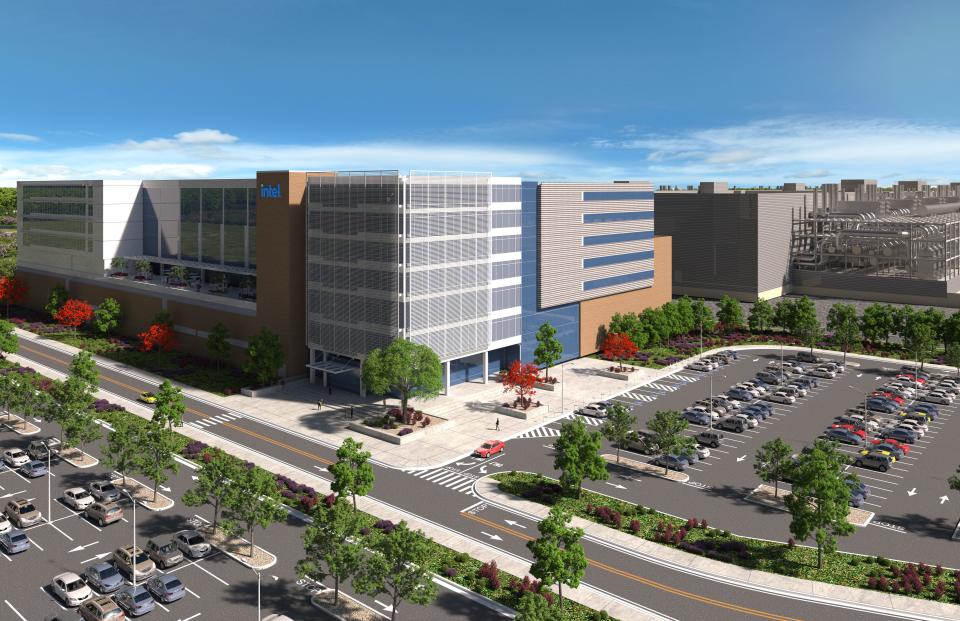Preparing for Intel a final exam for Licking County planners, officials

- Oops!Something went wrong.Please try again later.
NEWARK – For decades, Licking County has been anticipating a surge in growth and development on its western edge, eventually spreading countywide.
The pace of that growth has increased sharply in recent years, with Google, Amazon, Facebook and several others coming here, testing how well the county has prepared.
But the Jan. 21 announcement that Intel Corporation planned to build a $20 billion computer chip manufacturing facility on 1,000 acres of Jersey Township land annexed into New Albany, just south of Johnstown, feels like the final exam.
It’s the largest commercial development in state history and could grow to a $100 billion project. Intel plans to hire at least 3,000 to work at its fabs, but 7,000 construction workers will be needed. and the development will create 10,000 indirect jobs.
The groundbreaking event on Sept. 9 brought President Joe Biden, U.S. senators and representatives, the Ohio State University president , Gov. Mike DeWine, the OSU marching band and numerous other local, state, company and federal officials. Production is scheduled to begin at two Intel fabs in 2025, so although Licking County's final exam has begun, its grades won't be known for years.
“Everybody has been predicting this and here it is," Licking County Commissioner Tim Bubb said. "It’s exciting. We’ve been growing, but this puts an exclamation point on it. Like what Delaware County went through, but more orderly and predictable growth.
"This represents over the next decade an opportunity for the next generation we couldn’t have dreamed would exist in this area. It will make a difference in their lives. Career opportunities are going to be here. You’ll have kids who moved away from central Ohio with degrees, they’ll be looking right back at central Ohio. The airplanes fly both directions.”
The development will test the county's ability not only to provide the employees, but all aspects of life -- housing for all the workers, education for their children, a reliable transportation network and public transit, utilities, police and fire protection, recreation, entertainment options and retail stores.
State Sen. Jay Hottinger, R-Newark, said such a massive development into a traditionally rural area comes with pros and cons. He said the employment opportunities are staggering, with annual salaries expected to average $135,000.
“In my 31-year public-service career, it’s always been about jobs, economic development and growth," Hottinger said at the groundbreaking. "This is larger than Honda and Wright Patterson combined. That puts it in perspective.
"Traffic, homes, landscape will change, but I will argue that’s a heck of a lot better than the alternative. I have seen stagnant areas. I represent some stagnant areas. You can’t stand still. There are problems and growing pains that come from growth. I’m not going to sit here and tell you know it’s going to be problem-free, but those problems will be addressed, and we’ll mitigate them as best we can.”
Intel CEO Pat Gelsinger told The Advocate at the Sept 9 groundbreaking that finding employees will be critical. The county's unemployment rate tied an all-time low in November at 2.7%
“Talent is a huge issue," Gelsinger said, "Talent is always a challenge. I am always concerned about that. The talent we’re announcing today, those programs, we won’t need for 4-5 years, and that’s perfect. That’s why we’re launching the programs today.”
Intel met with representatives from Ohio’s 23 two-year colleges in May. At the meeting, the schools shared their curricula, and Intel shared what it will look for in future employees. This gave the two-year colleges the opportunity to make curricular adjustments that would better prepare students for engineering careers with Intel.
Since the May meeting, COTC and Intel have established what COTC President John Berry describes as a “standing connection.” Communication comes with incentive on both sides: Just as Berry wants COTC students to have opportunities with Intel, Intel needs to hire a lot of workers, many of whom Smith says will come from two-year colleges.
Framework project enters Phase 2
The Evans Foundation stepped up to provide a public-private planning effort, called Framework, to prepare for Intel. The effort includes 15 governmental jurisdictions and private sector business partners seeking solutions on a variety of issues. It seeks to align communities most immediately impacted by Intel’s construction.
Evans Foundation chairwoman Sarah Wallace announced the formation of the Licking County planning effort in June, following initial meetings in April. She provided an update on Dec. 9.
Wallace said the three-phase process is moving into the second phase, which is analyzing public input and conducting technical research for the plan. This phase will continue into the spring.
The final phase of developing a strategy should be completed in the summer, she said.
From Oct. 1 to Dec. 9, the Framework project received 1,688 responses from a survey and input sought at a variety of locations, including football games, farmers’ markets, service club meetings, on social media, and special events hosted at local businesses and educational institutions.
“It was much more than we anticipated,” Wallace said of the response. “We are real happy with it. We have worked really hard.
“We got a lot of comments about schools, and greenspace and how people care about the atmosphere in their community and retaining that small-town feel.”
Initially, it was thought Intel would attract 30 to 40 suppliers new to central Ohio. Wallace said that may not be the case.
“Probably not more than 12 to 15 (new ones)," Wallace said. "A lot of those suppliers we already have.”

Intel has already set aside 200 to 300 acres for supply chain companies within its 1,000 acres, Wallace said.
Housing key element
Kevin Hively, founder of Ninigret Partners, is doing extensive research in partnership with Planning NEXT on the housing market, Wallace said.
The housing crunch may not be as bad as some expect, Wallace said, because the Intel employees will find housing all over central Ohio. Currently, more people work in Licking County and live outside the county (33,000) than those who live and work in the county (27,000).
Still, housing demand may drive up housing prices too much for some to afford.
“We think we have a lot of people who can’t afford to downsize because there won’t be a lot of places to move to," Wallace said. "We hope senior citizens can afford to live in their communities.
“This is where diverse housing options need to be there. We have a pretty good stock of houses, but we can’t just build half-million dollar houses."
Hively said 61% of the new housing units will be for prospective new residents with incomes higher than the current median household income of $71,058.
Wallace said the study shows the county needs more housing units now to meet demand, it needs the right mix of diverse housing options and affordability will be an issue for some
"There will be a pool of new residents who will have affordability issues," the foundation report states. "In order for a community to have a healthy housing mix we should have opportunities for residents to step up and step down over the course of their lives and stay in our community.
“An important thing to make sure everybody understands what diversity in housing means and how it can serve all the population. It’s so important.”
Of the county's population, 38% are at the “empty nest/downsize” phase of life and 30% is “retired/aging in place."
740-973-4539
Twitter: @kmallett1958
This article originally appeared on Newark Advocate: Intel not just a test, but final exam for planners, local officials

